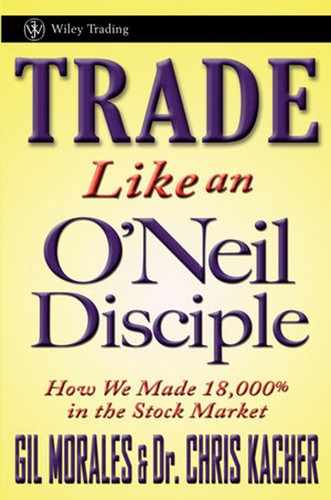2.8. 2002 TO PRESENT—CHOPPY, SIDEWAYS MARKETS AND THE BIRTH OF THE POCKET PIVOT
The year 2002 was also uneventful, and I stayed mostly in cash. I remember many funds closing their doors. While 2001 was a massacre, 2002 was equally brutal. Few were left standing. Once the NASDAQ Composite was off more than 70 percent, the market seemed to be excessively oversold. So I decided to take a small position in the QQQQs for a long-term play. I reasoned that the market could go lower but historically, had always resumed a strong rally after being so oversold. This was true after the panic of 1907, after the Great Depression when the market lost almost 90 percent of its value, and after other serious market setbacks dating back to the nineteenth century.
So 2002 was profitable by a hair due to this one trade, which reversed my small losses. My losses had been small because I remained mostly on the sidelines, safely in cash. That said, I would have been nicely profitable had I shorted indices on any sell signals issued by my timing model. This was also true in other years. Thus, this bias I had toward staying in cash during bear markets was replaced starting in 2009 with the action of shorting major indices on sell signals; 2008 was a wake-up call to start shorting the major indices as 2008 was a good year for my timing model, as shown in Figure 2.15, due to the collapse in the general markets. The return of +31.1 percent is good, but under the model's long-term average annualized returns of +33.1 percent. But when accounting for optimization of the follow-through day threshold, which I discuss in Chapter 7, the return increases to +38.8 percent for 2008. I prefer to err on the side of absolute caution, so I show the "worst-case" situation of +31.1 percent.
Note, the timing model's back-tested historical average of +33.1 percent/year from 1974 to 2006 was achieved by going 100 percent long the NASDAQ Composite on a buy signal (B), 100 percent short the NASDAQ Composite on a sell signal (S), and 100 percent cash on a neutral signal (N). In working with my model in real time since 1991, the returns in my personal and institutional accounts were larger because I was buying individual stocks during periods when my model was on a buy signal.
Figure 2.15. NASDAQ Composite Index daily chart, 2008. The "Slow Motion Crash" of late 2008.: Chart courtesy of eSignal, Copyright 2010

The toughest year for my model was 2007, as it was one of the only two years when the model was down in its entire 36-year run. Its negative return of 10.9 percent was due to a large number of false price/volume signals. That year, distribution day clusters often did not lead to a falling market, as the market continued to grind higher. This may have been due to the many one-time confluences of cross-currents including the end of the housing bubble, the early stages of a breakdown of financials as seen in the XLF index, and the beginning of the recession. Fortunately, years such as 2007 are extremely rare. On balance, my timing model continues to keep me on the right side of the market cycle after cycle. For historical interest, Figure 2.16 shows my timing model in action during the crash of 1987 and its aftermath.
In the current decade, the compressed, sideways markets observed from January 2004 to August 2006 brought new trading challenges, as shown in Figure 2.17, and my market direction model's returns, while still ahead of the major averages, have been under its historical returns of +33.1 percent/year.
Figure 2.16. The timing model during the 1987 market crash clearly outperformed.: Chart courtesy of eSignal, Copyright 2010

Figure 2.17. S&P 500 weekly chart. Three years of difficulty.: Chart courtesy of eSignal, Copyright 2010

But whatever doesn't kill you makes you stronger. In late 2005, I came up with a major refinement to my strategy, which enabled me to make my initial buy in a stock's base just before it broke out, a method I call buying "in the pocket," which will be discussed in detail in Chapter 6. Not only does this refinement work today but also worked beautifully in prior 1970s, 1980s, and 1990s markets. Those of you who subscribe to The Gilmo Report will note that we have discussed them in some detail in prior reports, which can be found at www.gilmoreport.com. This technique will improve your investment performance should the market encounter choppy, sideways action that grinds higher, such as during much of 2004–2007 or during windows of opportunity such as the brief uptrends of September to November 2006 and September to October 2007.
Looking back, as the saying goes, if I only had known in the 1990s what I know now, my returns would have been higher. We are all students of the market, always learning, always optimizing, and hopefully always evolving. It certainly keeps the journey alive and well.
